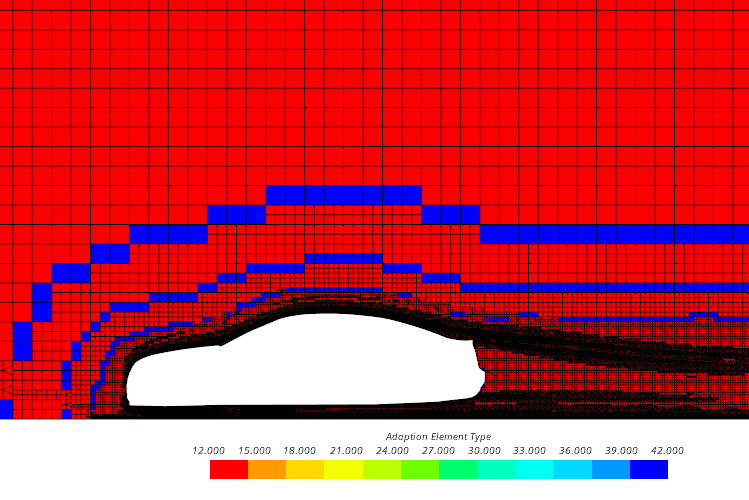Adaptive Mesh Model Reference
Within a physics continuum, the Adaptive Mesh model allows you to specify the mesh refinement settings based on selected criteria and method.
| Provided By | |||
| Example Node Path | |||
| Requires |
For a user-defined mesh refinement:
For a free surface mesh refinement:
For a Lsi mesh refinement:
For an overset mesh refinement:
For a reacting flow mesh refinement:
For topology optimization mesh adaptation:
|
||
| Properties | See Adaptive Mesh Model Properties. | ||
| Compatible Meshers |
|
||
| Activates | Physics Models | Adaptive Mesh | |
| Model Controls (child nodes) | Adaptive Mesh Criteria—See Adaptive Mesh Criteria. | ||
| Region Inputs | See Physics Conditions in Region Settings. | ||
| Solvers | See 自适应网格求解器参考. | ||
| Field Functions | See Field Functions. | ||
Adaptive Mesh Model Properties
- Adaption Mode
- Displays the mesh refinement method. Currently only the option Mid-Point Subdivision is available.
- Prism Cell Refinement
- Specifies the following
refinement option for prism cells.
- None
No prism cells are refined. This option also limits the refinement of core cells adjacent to the prism cells.
- Isotropic
All the prism cells are refined/coarsened in all three dimensions, that is, as core mesh cells that are also refined in an isotropic manner.
- Tangent
All the prism cells are refined/coarsened in a tangential direction. The number of prism cell stacks increases while the number of prism layers is preserved.
- Normal
All the prism cells are refined/coarsened in a normal direction. The number of prism layers increases while the number of stacks is preserved.
- Criterion
Based
If required, you can achieve anisotropic prism cell refinement using active Adaptive Mesh Criteria.
User-Defined Mesh Criterion specifies anisotropy for individual boundaries (for prism cells incident with individual boundaries) through the boundary physics conditions.
When activated, a node appears for each wall boundary. This node provides the following Prism Refinement options:
- Unspecified: This value allows other adaptive mesh criteria to specify anisotropy for the prism cells. If no anisotropy is defined and the prism cells are still required to refine, the cells are refined isotropically.
- Isotropic: As described above.
- Tangent: As described above.
- Normal: As described above.
To avoid generating unsupported cell configurations, the Adaptive Mesh model can choose isotropic refinement rather than normal or tangential refinement for individual cells.
- None
- Initial Mesh
- Specifies the type of the initial input
mesh. This property is designed for the trimmed cell mesher, which
determines whether the octant depth from the initial trimmed cell mesh is
recognized or ignored. In Trimmed, the octant depth
indicates the number of splittings applied to a cell with respect to the
bounding box of the mesh domain. When the octant depth is converted to the
refinement level for the Adaptive Mesh model, it is rescaled with respect to
the biggest/least split cell (refinement level = 0) in the mesh. Cells with
half of the biggest cell size obtain the refinement level 1and so on. See:
Refinement Level.
For polyhedra mesh, this option is not applicable.
The available options are:
- Trimmed (HEX)—specifies
that the initial mesh is a trimmed mesh and activates the Trimmed
Mesh Support.
This option is only relevant for meshes generated using an automated mesh operation with the Trimmed Cell Mesher.
- Auto Detect—activates the auto detect functionality for the initial mesh. The octant depth is converted into the refinement level if available. Otherwise it is set to 0 for all the cells.
- General (default)—indicates that the Adaptive Mesh model treats all the cells in an input mesh with refinement level 0.
The following illustration represents the adaptive mesh refinements with and without Trimmer Mesh Support:

- Trimmed (HEX)—specifies
that the initial mesh is a trimmed mesh and activates the Trimmed
Mesh Support.
- Transition Width
- Specifies the cell width of
transitional zones between different refinement levels. Transitional zones
introduce cells of refinement level N between level N+1 and level N-1 and
therefore reduce the rate of volume change. Default value 1 refers to the
base size width.
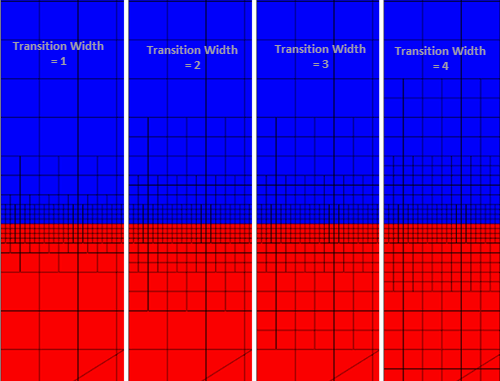
The continuous propagation of transition zones extends across direct boundary interfaces created through imprint. Transition zones do not propagate across the interface into a region with adaption disabled.
- Limit Cell Size
- When activated, the proposed child cell size is checked against the Min Adaption Cell Size during the mesh refinement. If the predicted child cell size falls below the limit, the refinement is not executed for the parent cells.
- Min Adaption Cell Size
- Defines the minimum cell size permitted within all regions that use the relevant physics continuum. This limit prevents creation of too small cells. It does not force cell coarsening, that is, cells below the minimum size stay in the mesh unless some criterion requires their coarsening. However, due to the estimation error, cells whose size falls slightly below the minimum cell size can be generated. Default value is 1e-6.
- Check Refined Cell Quality
- When activated, the Cell Quality of each proposed child cell is compared against Min Cell Quality. The mesh refinement stops for cells where the value is not achieved.
- Min Cell Quality
- Specifies the minimum acceptable Cell Quality of refined cells. Default value is 1e-5 . For a definition, refer to Cell Quality.
- Check Least Squares Quality
- When activated, the Least Squares Quality of each proposed child cell is compared against the Min Least Squares Quality.
- Min Least Squares Quality
- Specifies the minimal Least Squares Quality of cells. The Default value is 0.001. For a definition, refer to Least Squares Quality.
- Check Face Validity
- When activated, the Face Validity of each proposed child cell is compared against the Min Face Validity.
- Min Face Validity
- Specifies the minimum acceptable Face Validity of cells. Default value is 0.9. For a definition, refer to Face Validity.
| 注 | The mesh quality is not checked for preserved and coarsened cells, but only for prospective child cells that result from the proposed refinement. Consequently, no check is made for the impact of cell (face) refinement on the neighboring preserved cells. |
Adaptive Mesh Criteria Right-Click Actions
- New
- Based on the selected physics
models, one or more of the following adaptive mesh criteria are available
for creation:
- User-Defined Mesh Adaption
- Free Surface Mesh Refinement
- Lsi Mesh Refinement
- Overset Surface Mesh Refinement
- Mesh Adaption for Reacting Flows
- Virtual Disk Mesh Refinement
- Topology Physics Mesh Adaptation
Adaptive Mesh Criteria Properties
- The Adaptive Mesh
Criteria node contains all the specified mesh adaption
criteria. The created criteria apply to all regions that use the parent
physics continuum. Refer to the following table to set up the corresponding
properties:
Criteria Option Corresponding Sub-nodes User-Defined Mesh Adaption - Max Refinement Level
- Sets the maximum limit on the number
of times a cell can be refined in a simulation.
One refinement level for a cell means one step of midpoint subdivision. The resulting number of child cells are equal to the vertices of the parent cell.
For Hexahedron cells, one refinement level means 8 subdivided child cells from one parent cell as shown in the image below:
For poly cells, the midpoint subdivision results in as many child cells as there are vertices in the parent cell, that is, typically 12-15 child cells. One example is shown in the image below: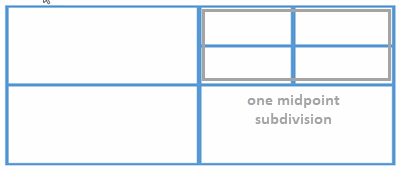
The refinement level increases or decreases only by one level in each adaption—mesh adaption is a successive procedure.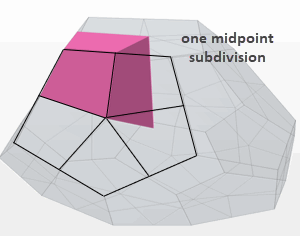
- Enable
- Activates this user-defined mesh adaption
- Refine in Solution Initialization
- When active, mesh refinement is applied during
solution initialization. Initial solution
refinement can trigger AMR more than once and so
increase the refinement level above 1 before the
simulation starts. Mesh coarsening is not possible
here because AMR cannot coarsen the initial
mesh.
注 Before activating this option, make sure that your initial solution reflects the basic flow characteristics. Otherwise the adapted mesh could hinder flow convergence. Only activate this option when you start from a well-converged steady solution, for example, when switching to a transient simulation from an initial steady simulation.
Adaption Request - Method
- Specifies one of the following methods of mesh
adaption.
- Adaption Criterion
Function
Here you select one scalar function of interest and specify two value thresholds that define adaption behavior. For each value range, you set an adaption option explicitly—refine, keep, or coarsen.
- Scalar Function
Selects the scalar function of interest. You are advised to use gradients or Laplacians of physical quantities. For example, grad($Temperature) for CHT refinements.
- Range
Specifies a range with two value thresholds.
- Above Max
Defines adaptive behavior when the Scalar Function value in a cell is above the Range upper limit.
- Between
Defines adaptive behavior when Scalar Function value is within the Range.
- Below Min
Defines adaptive behavior when Scalar Function value is below the Range lower limit.
- Scalar Function
- Field Function
Selects a user-defined field function whose value determines the adaptive behavior by returning -1, 0, or 1 with meanings as follows: The cell is refined if the returned value is 1.0 (actually > 0.8); coarsened if the returned value is -1.0 (actually < -0.8); kept if the returned value is 0.0 (actually -0.8 < ff < 0.8)
- Table
(xyz,time)
Specifies mesh adaption behavior for each cell using a location/time table. The cell is refined if the table value is 1.0 (actually > 0.8); coarsened if the table value is -1.0 (actually < -0.8); kept if the table value is 0.0 (actually -0.8 < ff < 0.8)
- Adaption Criterion
Function
Free Surface Mesh Refinement None Lsi Mesh Refinement Lsi mesh refinement restricts the mesh refinement to interface cells as determined by the Large Scale Interface Detection Model Reference model.
Additionally, the Lsi mesh refinement criteria uses a sharp reconstruction based interpolation technique to provide a sharp interface on the refined cells.
See Sharp Interface Reconstruction with Adaptive Mesh Refinement.- Max Refinement Level
- Sets the maximum limit on the number of times a cell can be refined in a simulation.
- Enable
- Activates the Lsi mesh refinement adaption.
None Overset Mesh Refinement None Mesh Adaption for Reacting Flows Variables Reacting flow variables for the error indicator, such as species mass fractions, temperature, mixture fraction and/or progress variable.
Virtual Disk Mesh Refinement None Topology Physics Mesh Adaption The topology physics mesh adaption is a mesh refinement criterion designed for Adjoint Flow with Topology Optimization simulations.
The topology physics mesh adaption criterion sets the refinement on the solid-fluid interface based on the gradient of the material indicator field. The refinement implements an AMR sensor to identify the relevant cells near the interface and refines the mesh accordingly. See Applying AMR for Topology Optimization for the AMR sensor definition.- Max Refinement Level
- Sets the maximum limit on the number of times a cell can be refined in a simulation.
- Enable
- Activates the topology physics mesh refinement adaption.
None
Physics Conditions in Region Settings
- Adaption Option
- Activates mesh adaption in this region.
Field Functions
The following field functions are made available when applying Adaptive Mesh Model.
- Adaption Cell Size
- Indicates the current cell size
in the volume mesh. The Adaption Cell Size is calculated as twice the
maximum distance between a cell centroid and any of the cell vertices, that
is, as an upper estimate of the diameter of a ball enclosing the cell.

- Refinement Level
- Indicates the number of times a
cell has been refined from its original state. For a trimmed mesh,
refinement level displays the original refinement level of the input mesh
plus the refinement done by the Adaptive Mesh solver.
- 0 - no refinement
- 1 - refined once
- 2 - refined twice and so on
- -1 - mesh adaption is disabled
注 The refinement level can increase or decrease by 1 level only during each execution of the adaptive mesh solver. Adaption is a successive procedure. To avoid a large volume change between cells, only one level of difference in refinement level is permitted between neighbor cells. 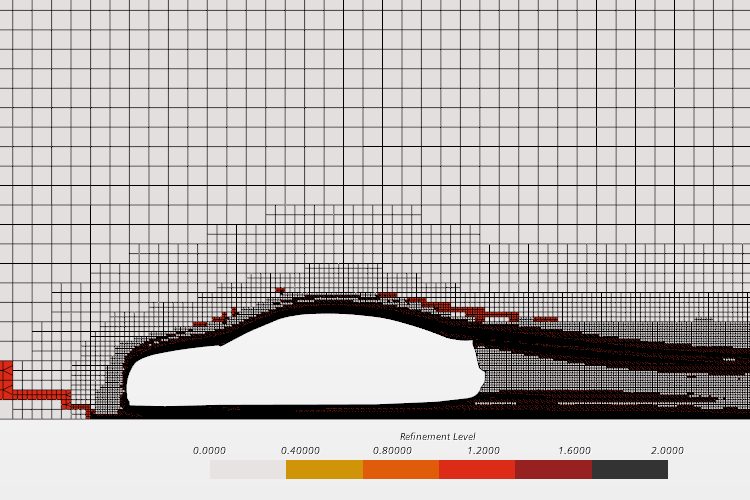
- Solver Refinement Level
- Indicates the number of times a cell has been refined by the Adaptive Mesh solver.
- Adaption Refinement Status
- Identifies the status of cells.
The available values are:
- 0 (Supported) - can be refined
- 1 (Fixed) - cells of incorrect octant depth provided by the trimmed cell mesher. Octant depth indicates the number of splitting the mesh root octant— a bounding box which encapsulates the whole mesh.
- 2 (Unsupported) - not supported cells. For example an unclosed cell.
- 4 (Inconsistent Refinement) - unrefinable cells in the initial trimmed mesh due to inconsistent cell configurations with neighboring cells.
- 8 (Disabled Prism) - prism cells whose refinement is disabled by the Prism Cell Refinement of the Adaptive Mesh model.
- 9 (Adaption Incompatible) - cells incident with a boundary interface to a shell region. Shell region refinement is not supported by AMR.
- 16 (Poor Quality) - cells that would result in poor quality child cells
- 33 (Too Big Face) - cells with a face having 32 or more vertices. Big face edges can not be divided through AMR.
- 34 (Inconsistent Refinement) - unrefinable cells from the current mesh due to inconsistent cell configurations with neighboring cells. Similar to 4, but used for inconsistencies appeared after one or more cell refinements. These cells can not be further refined. However, a coarsening back to the previous cell size is possible.
注 A cell with any value other than 0 is an unrefinable cell. 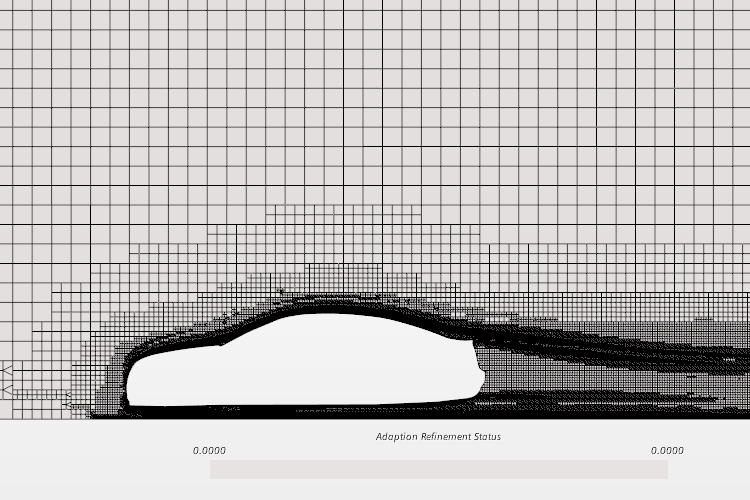
The image indicates that all the cells in the volume mesh can be refined.
The Adaption Refinement Status is not available immediately when the Adaptive Mesh model is selected. It is populated with one of the following actions:
- Trigged mesh adaption during the simulation run
- Right-click action 评估细化状态 of the Adaptive Mesh Solver
- Solution initialization
- Adaption Element Type
- Outputs element type identifier
as shown in the following table:
Element Topology Element Type Identifier Tetrahedron 10 Hexahedron 12 Wedge 13 Pyramid 14 Unidentified 41 Polyhedron 42 